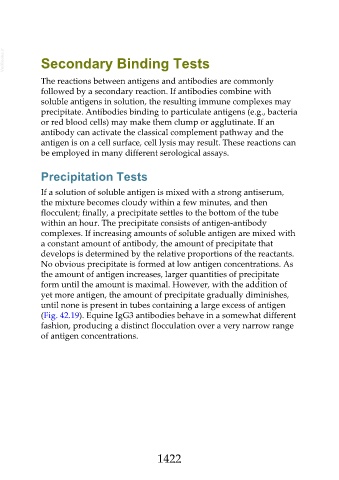Page 1422 - Veterinary Immunology, 10th Edition
P. 1422
VetBooks.ir Secondary Binding Tests
The reactions between antigens and antibodies are commonly
followed by a secondary reaction. If antibodies combine with
soluble antigens in solution, the resulting immune complexes may
precipitate. Antibodies binding to particulate antigens (e.g., bacteria
or red blood cells) may make them clump or agglutinate. If an
antibody can activate the classical complement pathway and the
antigen is on a cell surface, cell lysis may result. These reactions can
be employed in many different serological assays.
Precipitation Tests
If a solution of soluble antigen is mixed with a strong antiserum,
the mixture becomes cloudy within a few minutes, and then
flocculent; finally, a precipitate settles to the bottom of the tube
within an hour. The precipitate consists of antigen-antibody
complexes. If increasing amounts of soluble antigen are mixed with
a constant amount of antibody, the amount of precipitate that
develops is determined by the relative proportions of the reactants.
No obvious precipitate is formed at low antigen concentrations. As
the amount of antigen increases, larger quantities of precipitate
form until the amount is maximal. However, with the addition of
yet more antigen, the amount of precipitate gradually diminishes,
until none is present in tubes containing a large excess of antigen
(Fig. 42.19). Equine IgG3 antibodies behave in a somewhat different
fashion, producing a distinct flocculation over a very narrow range
of antigen concentrations.
1422

